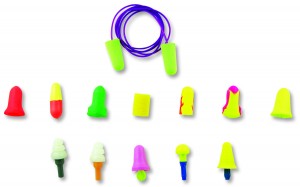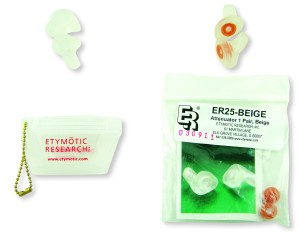by Joe Michaud
Two men are talking. One is bragging about his new hearing aid and says, “I have a new hearing aid…it’s wonderful. I can hear everything quite clearly.” Second man asks, “Really? What kind is it?” First man checks his watch and says, “Quarter to three.” If that sounds like you, you have the beginning of hearing loss.
Motorcyclists encounter auditory issues much like those of other hearing-loss candidates. And, like those others, our issues are often of our own making. Mary Wade, Au.D (Doctor of Audiology), with dry humor, maintains that motorcyclists exist squarely in the center of an auditory neighborhood that she calls “boy noise.”
Heck, noisy things are fun. One doesn’t have to be male to understand that.
The “boy noise” spectrum for motorcyclists includes wind noise, mechanical sounds from engine/exhaust/ tires and a host of peripheral ambient sounds. Out from amidst this cacophony, we must be able to separate hints of danger. Warning sounds like sirens, horns and encroaching cars must be safely discernible from the auditory clutter in our helmets.
As riders, our ears are affected by three variables; sound pressure levels, duration and, to a lesser degree, frequency. Let’s define some terms.
Our ears perceive sound pressure levels as “loudness.” Sound pressure levels are measured in decibels and are compared on a logarithmic scale. Each increment of 10 dB is a power of 10 in sound pressure level. Think Richter scale. The “loudness” piles up fast.

In the 1940s, sound studies done by the Occupational Safety and Health Administration culminated in accepted guidelines for the work place. If we review this data, we can see that sound pressure levels and duration are intimately related. We see that OSHA standards dictate that for every 5 dB increase, at levels greater than 90 dB on the A-weighted scale used by OSHA, the duration of allowable exposure is half.
There is some controversy among a burgeoning group of hearing care professionals regarding these OSHA guidelines. Some newer studies urge the indexing to be set at a more conservative 3 dB.
Independent of sound pressure levels and duration of exposure is frequency. Frequency is the “pitch” of a particular sound. High-pitched sound will often seem “louder” or more painful at the same intensity as lower-pitched sound.
Doctor Wade advises, “What is safe for one set of ears may not be safe for every person or every ear. If, after noise exposure, you notice that hearing seems diminished, your ears feel full and/or you have ringing (tinitus), your ears are sending you a 911 call. If the symptoms are temporary, you know you dodged a bullet. If the changes are permanent, well…then you live with hearing loss and ringing in the ears.”
As riders, we need to differentiate between “good noise” and “bad noise.” The constant rush of wind noise is a bad noise and is responsible for masking other sounds. Sounds like sirens, horns, radar detectors, GPS audio prompts and our own engine sound (as a speed check) are all good noises. We’d like to attenuate them as little as possible.
Up to 40 mph, wind noise is usually not a problem; our ears are still operating within their design envelope. As speed increases past 40 mph, wind noise rises at a much faster rate. Our ears quickly become overwhelmed.
Let’s look at some studies that relate to motorcyclists.
Careful testing has determined accurate in-helmet measurements of wind noise intensity at varying speeds. One British study at the University of Southampton was done to measure real-world sound risks involving “working motorcyclists,” like policemen or messengers.
After inserting calibrated microphones into the outer ears of riders, controlled tests were run both on the street and in wind tunnels. The study found that wind noise increased dramatically over 40 mph and quickly obscured any engine, exhaust or tire noise.
This study, done on BMW K-bikes, tested 27 helmet samples of 13 different types at speeds up to 70 mph. Surprisingly, at 70 mph, in-the-ear wind intensity averaged 100 dB despite any differences in helmet technology.
This research was done with both full-face and open-face models, vents open, vents closed and with/without chinbar wind controls. Helmets were ultimately modified with tape-sealed shields and different visor lengths, and some shell shapes were altered with plastic or cardboard “spoilers.” One manufacturer supplied prototype helmets with altered interior shells at the ears, chinbar and forehead.
Norm Matzen (www.theearplug guy.com) says, “An extensive amount of testing in wind tunnels at various universities as well as police authorities have characterized 500 Hz noise (the frequency of helmet-attenuated wind noise) very well…. It was found that essentially all helmets are equally susceptible to this noise. The statistical difference in a very large sample of different brands and models of helmets showed only a 1 dB variation in noise at the ear.”
The U.S. Department of Transportation study titled “The Effects of Motorcycle Helmets on Seeing and Hearing” agrees when it states, “…in the hearing tests, no significant difference was found in a rider’s ability to hear traffic, either between helmet types or between helmet and no helmet. Hearing ability was significantly affected by vehicle speed due to increased wind noise…. For any given speed, helmets did not diminish nor enhance hearing.”
Matzen explains that the sound pressure level at the ear for helmetless riders is 20 dB more than with a full or partial coverage (ears covered) helmet. So much for hearing “better” without a helmet. Once past approximately 40 mph, it just isn’t so despite intuitive beliefs. Every helmet tested in these studies—full-face or open-face, expensive or cheap—allowed over 100 dB inside at 70 mph.
Since decibel levels for wind noise at various road speeds are well known and testable, they can be cross-checked on the OSHA chart for acceptable time exposures for that level of sound. How fast do you ride? How long do you ride? Let’s do some math.

We can see by the OSHA chart that exposure to 85 dB over eight hours is considered “acceptable” for most people in the workplace. However, a speed of 55 mph produces 90dB. How many hours do we ride at 55? Tell the truth.
If we up the ante to a more reasonable pace, say, 75-80 mph, we subject ourselves to approximately 105 dB wind noise. OSHA recommends exposure at that level be limited to one hour. Does that sound like fun on a long trip? Nope. So, what can we do?
Well, that’s easy. Attenuation, my friends.
The ubiquitous “foamie” earplug is popular due to cost and availability. Foamies work well and are capable of 20-30 dB attenuation. However, failure to properly insert them can reduce their effectiveness by 20 dB or more.
It is imperative that any compressible earplug be installed into the bony part of the skull rather than the fleshy cartilage of the outer ear. Foamies should be tightly compressed, inserted deeply into the ear canal, and then held in place for 10 seconds allowing them to expand correctly. If they feel loose when installed, they are.
More technical plugs do exist. Audiologists can make deep-ear custom plugs that fit each ear precisely, removing the onus of improper installation.
The ideal plugs are the earplugs designed for musicians. They attenuate flatly across the frequency spectrum at a set decibel. Foamies typically attenuate high frequencies more than low, while a flat attenuating plug diminishes sound evenly, much like sunglasses do for glare. It’s essentially like turning the volume down. These are a true joy to use. Some custom earplugs, like those of Etymotic, give the wearer the option of setting the attenuation to any of three levels simply by replacing a removable baffle.
An improperly installed earplug of any sort, when worn inside a helmet, can get darn painful after a few miles. No one wants to remove a helmet to rearrange an earplug, so ill-fitting or painful plugs tend to not get used. Custom molded plugs obviate this problem but you pay a price up front.
There are many shapes, types and designs of noise-attenuating earplugs. They all have their good points. Three of us tested as many types/brands/ shapes as we could gather on a 1,000-mile ride to Laguna Seca for the MotoGP in July 2005. Our results may lack true scientific methodology, since we used three different heads fitting into three different helmets and we rode three different and disparate machines, but we’ll reveal what we found, and what we liked. None of us were earplug users before. The results surprised us.
The scores are averaged 0-10 from three riders. The plugs we deemed untestable all had small plastic handles that eased “no touch” insertion. Effective at trackside but they protruded too far from the ear for helmet use.
The Bottom Line?
The best bet are foamies; cheap but very effective. Some vendors can provide convenient sampler packs, like www.aerostich.com. Buy ’em all and try ’em all. Practice inserting them correctly. Find a pair that fit your particular ears well, and then buy ’em in bulk. For even greater protection, you may want to step up to the Etymotic Musician custom ear plugs. With their optional attenuation levels of 9, 15 and 25 dB and the comfort of the added custom ear mold, these are the true Gold Standard for attenuation. Comfy and effective. I wear my 25s religiously now, and wish I had for the last 20 years.
SOURCES
AOSafety, www.aosafety.com
E-A-R, www.e-a-r.com
E-A-R, Peltor, AOSafety, http://aearo.com
E-A-R, Insta-Mold (not tested), www.earinc.com
Etymotic, www.etymotic.com, www.theearplugguy.com
Max, Etymotic, E-A-R, Moldex, Sample Kits, www.aerostich.com
Max, Max Lite, Multi Max, Laser Lite, www.howardleight.com/products/
Moldex, www.moldex.com/foamplugs.htm
[From the February 2006 issue of Rider]








Started wearing foamies after reading an article in Rider about earplugs and hearing loss. I already have age/genetic hearing loss, so I was interested in protecting what I’ve got left.
Overall comfort on my daily freeway commute was immediately
evident. I could still hear everything that was going on around me, and it felt even clearer than without protection.
If your hearing’s still good, I’d strongly recommend using earplugs on a regular basis. If you haven’t used them before, I think you’ll be pleasantly surprised. And it’s a lot cheaper than buying hearing aids!!
Thanks for sharing your thoughts about hearing protection for
motorcyclists. Regards